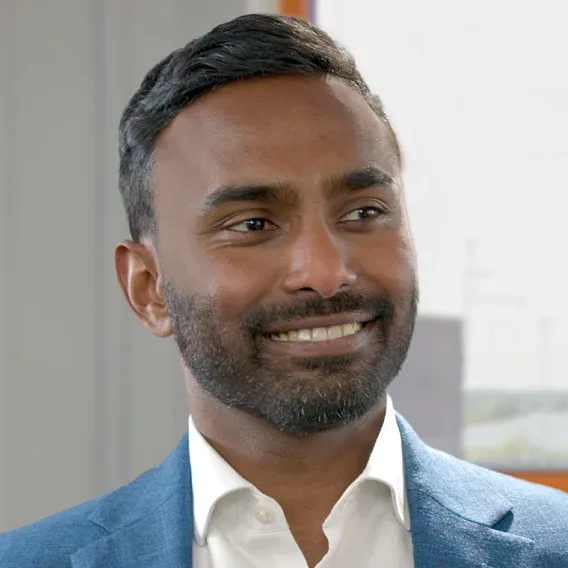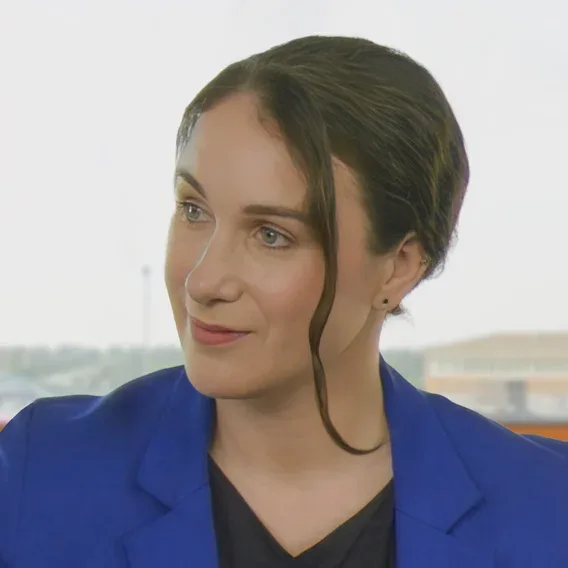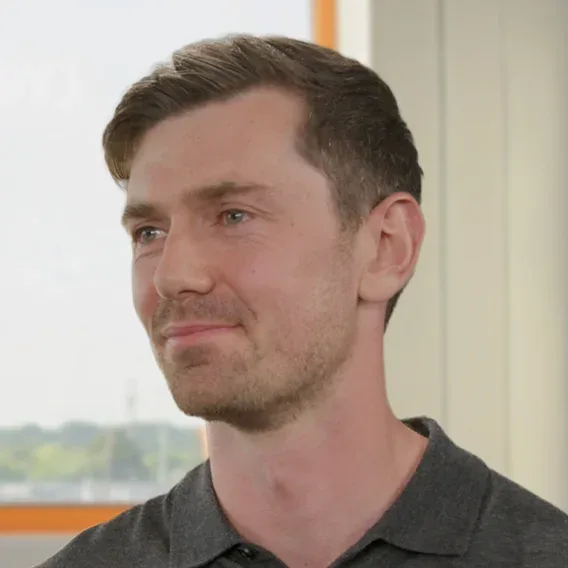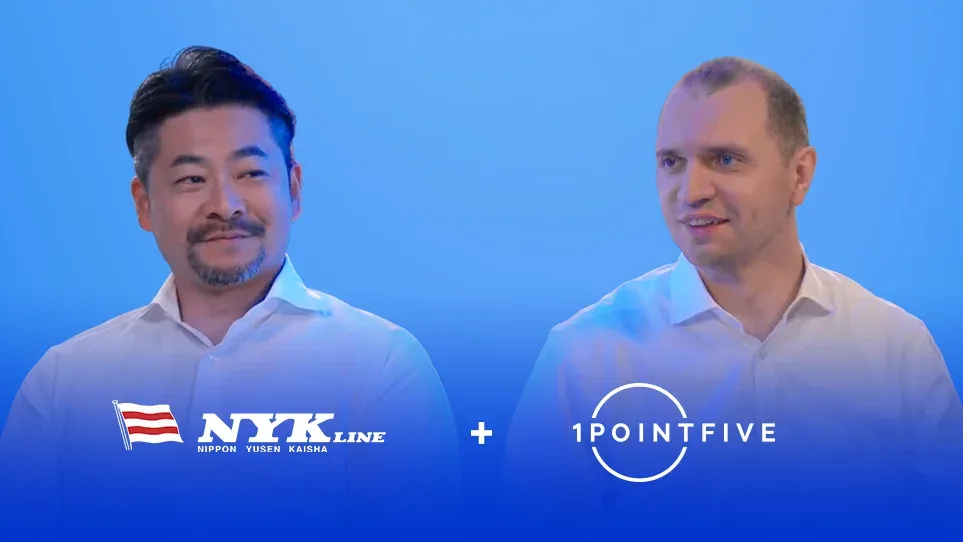Episode Preview
Lahiru Ranasinghe (00:00):
This is a global problem for a global industry that needs a global solution, and to scale up the technologies that we need for aviation to decarbonize—That's SAF, hydrogen and removals, you'd want to make them as accessible as possible to as many companies as possible.
Ian Collier (00:21):
Yeah. And it’s really important that we scale all the pieces.
Anna Stukas (00:25):
Right, so that you can really leverage those two complementary mechanisms of the removals and the SAF working together to get you to net zero.
Introduction
Anna Stukas (00:42):
Welcome to Speaking in Tonnes. I'm your host, Anna Stukas. I'm here today at the easyJet hangar at Luton airport with my 1PointFive colleague Ian Collier.
Anna Stukas (00:51):
Our guest today is Lahiru Ranasinghe, the Director of Sustainability at easyJet. Lahiru, thank you so much for joining us today.
Lahiru Ranasinghe (00:59):
Thank you very much, Anna. And welcome to Luton.
Lahiru’s Path to Sustainability
Anna Stukas (01:01):
So you've been working across the aviation sector, starting as an aerospace engineer, and coming most recently as Head of Net Zero at easyJet. And now taking on the role of Director of Sustainability. Can you tell us a little bit about your journey? What brought you here? What sparked that interest in sustainability?
Lahiru Ranasinghe (01:21):
I've always been one of those kids who loved planes, loved flying. And so it was no accident that I went into aeronautical engineering. Somewhere along the line, I started becoming more and more concerned by what's going on in the world in general in terms of environmental damage. I suppose there was serendipity because after I joined easyJet in the strategy team, I had the privilege of working with and for the sustainability team to help them to develop the net zero roadmap.
The Three R’s: Reduce, Replace and Remove
Anna Stukas (01:54):
As you're thinking about that net zero roadmap, there are the big pieces that everyone thinks of in there about efficiency and sustainable aviation fuels, but also carbon removals. Can you talk a little bit about how you brought all of those pieces together in your net zero roadmap?
Lahiru Ranasinghe (02:10):
We have this mantra of the three R's: That's reduce, replace and remove. And we think of this in terms of energy. So reduce is reduce our energy usage. So that's all about efficiency. And that's using the most efficient aircraft. It's then how we operate those aircraft. And it's also about how the airspace, the highways in the sky are managed. Now, we're clearly not going to optimize our way to net zero. So this is where the replacement of fossil fuels with non-fossil alternatives, such as sustainable aviation fuels or SAF and hydrogen come in. For example, if I said we got our first hydrogen aircraft tomorrow, it would still take the best part of 25 years for us to replace a fleet of aircraft the size of ours. So there would always be a relatively large residual emissions component this side of 2050 that needs to be addressed. So this is where removals comes in. We recognize that it is something that has to be a significant part of our journey and aviation's journey to net zero, both for residuals, but also as a component or feedstock for part liquid or E-SAF.
Why Aviation Needs Carbon Removal
Ian Collier (03:22):
How do you explain to people why carbon removal matters in aviation, even if you're already working on things like SAF and operational efficiency?
Lahiru Ranasinghe (03:30):
Aviation is a really hard-to-abate sector and for a good reason. Regardless of whether we follow a pathway that is completely SAF-focused, or if we went completely hydrogen-focused, or some or what would be reality, which is some combination of the two, we would still have carbon emissions into 2050. Therefore, carbon removal becomes a very important part of that story. So to put it in really short terms, we are not going to be able to get to zero emissions as an industry by 2050. So we need to have something to take out what we are putting into the air. That's where carbon removals comes in.
Ian Collier (04:09):
What's the key to making sustainability work, within your low-cost airline strategy?
Lahiru Ranasinghe (04:14):
Really, the key is balancing the long term and the short term. We recognize that sustainability is what's going to give us our license to operate in the long term. To really bring it to life and make it work for the business, we also then have to make it work in the short term. So the way we are addressing sustainability is not to have the business and sustainability. It is to make sustainability work with and for the business and vice versa. This is the philosophy that sustainability and business are not two different things. They’re one and the same.
Anna Stukas (04:46):
Absolutely. If we gave you a magic wand, what would you want regulators to know about how to accelerate sustainability initiatives within a global industry?
Lahiru Ranasinghe (05:00):
So if I had said magic wand, I'd wave it with the acknowledgment of the fact that this is a global problem for a global industry that needs a global solution, and to scale up the technologies that we need for aviation to decarbonize—That's your SAF, hydrogen and removals. You'd want to make them as accessible as possible to as many companies as possible. And for that, you'd want to have a global market. Global market would mean aligned regulations and standards around the world, and you've got the allocation of resources and capital in the most efficient way in a global market that allows companies like ourselves and the rest of our airline peers to then invest or buy in such a way that follows that market.
Anna Stukas (05:59):
So that fungibility so that one thing that you buy somewhere you can use it in whatever place it makes the most sense.
Lahiru Ranasinghe (06:06):
Absolutely. Maximum liquidity.
Scaling New Technologies
Anna Stukas (06:06):
Scaling new technologies from sustainable aviation fuel to Direct Air Capture is not easy. And it's also going to be critical to reach net zero. So what are your thoughts on how we scale these new technologies?
Lahiru Ranasinghe (06:23):
I'd like to bat that back to you, because 1PointFive is one of the success stories that demonstrates how technology can go from development to a commercialization stage.
Anna Stukas (06:35):
So we started with a really simple approach to our technology of how could we look and borrow things from other industries, combine them in a novel manner to do something that our founder likes to say, capturing CO2 out of the atmosphere is easy. What's challenging is capturing atmospheric CO2 cost-effectively at climate-relevant scales. And so to do that, we wanted to minimize the need to develop new supply chains, but to be able to leverage existing supply chains. I think the second piece to our success was really having patient capital and the right strategic investors, including our now-parent company Oxy, who are able to see the vision that we had and be able to really see how what they were bringing to the table could also really complement us getting to scale.
Lahiru Ranasinghe (07:24):
You touched on a couple of things there that are quite pertinent to what I was saying about our journey as well. It's that it's having the eye on the long term and understanding the long-term vision and the strategy, but also making it work in the short run. In your case, that the technology kept being developed and the company didn't go bankrupt. But I think this is a really great example because it shows that it is possible. The technology you’re developing, it's not something that's been around at scale until the likes of yourselves started bringing it to that scale. And I think when we look across the aviation ecosystem at SAF, hydrogen, etc., it's two things that come into play. It's the fact that there was a really long-term return on investment cases, and that they're still seen as risky in terms of investment that are holding it back. And there needs to be a lot more work to de-risk those early investments to be able to really unlock the potential that these technologies and industries offer, not just looking at it from the aviation perspective, but in terms of the broader macroeconomic potential that it offers.
Anna Stukas (08:40):
How do we make sure that we're not incentivizing one thing at the expense of another, that we're making sure everything scales together?
Lahiru Ranasinghe (08:48):
That's a really good point, because there is a risk of one technology being seen as favorable over the other. And now there's a very delicate balance between incentivizing removals to scale up, and also into incentivizing hydrogen to progress, while also making sure that the wind is not taken out of the sails of the SAF journey. One of the things that can help significantly in this way is the approach of governments taking upfront incentives to incentivize the, you know, the establishment of the plants that are necessary and the scale up of the technology. And by the way, it can be seen as me, you know, sitting here as the airline and saying, cap in hand, government should be funding everything. We should think about this in terms of financing as well. It's not just about grants and incentives in that sense. It is also about unlocking some of the financing for these projects, because ultimately they are going to result in economic progress through those new nascent industries, but they're also going to enable an already existing and mature part of the economy, which is a massive driver of the global and European economy, aviation, to continue to thrive, but to thrive in a way that is much more sustainable than what we've become accustomed to.
Ian Collier (10:12):
Yeah. And that's really important that we scale all the pieces, because in aviation's net zero future, we’re going to need not only SAF, not only hydrogen, but removals as well.
Lahiru Ranasinghe (10:22):
Absolutely. We need it all. We can't afford anything to slow down. But we do need everything to speed up because they are complementary to one another.
Gaining Government Support
Ian Collier (10:32):
What kind of support from the UK government would make it easier for airlines like yourselves to decarbonize?
Lahiru Ranasinghe (10:38):
What is needed now is that upfront support to help to de-risk that early-stage investment. The tricky balance that has to be achieved is to be able to do that without it having a massive impact on the consumer, and especially from a low-cost carrier’s perspective. Our whole mission is to keep flying affordable for the average person. So what would really help us as an industry at this point in time is the formal recognition of removals as a reduction in your overall carbon footprint with the associated tax impacts as well. And in this case, we're talking about the removal of the UK's emissions trading scheme, the ETS costs on those carbon credits, because right now what happens is we pay for those carbon credits, which are several $100 a tonne of carbon, we would still be subject to the ETS. On top of that, the consultation has taken place in the UK. But again, for all of these things, we need, you know, we need all the policies and mechanisms and the certainty to be there yesterday for us to be able to move forwards faster.
Anna Stukas (11:56):
Right, so that you can really leverage those two complementary mechanisms of the removals and the SAF working together to get you to net zero.
“Cool Takes”
Ian Collier (12:09):
The next segment is cool called Cool Takes. So that's where we look back at certain things that you've said in the past and we review them today.
Ian Collier (12:18):
I'm sort of interested in one of your posts from 2024 about easyJet purchasing over 100 tonnes of neat SAF on behalf of Airbus for their business travelers. You wrote that “This is a proof of concept for a much bigger vision. We're aiming to make it easy for our customers to address their travel emissions and play a role in scaling up SAF supplies.” My question is, how do you see the use of corporate partnerships to increase the use of green technologies in your portfolio, and how do you see that evolving over time?
Lahiru Ranasinghe (12:50):
We basically want to use as much of these technologies, these decarbonized technologies as we can afford to. We are subject to the mandates, but we would like from our perspective to uplift more SAF than that and eventually be uplifting more removals as well, so that we can accelerate our decarbonization journey. Now, it's not just us as corporates that have to do that. Our corporate customers also need to do that. So what we were trying to develop here was something, a mechanism, a really dead-simple mechanism that enables us to pick up voluntary SAF on behalf of our corporate customers. Now, it's still early days, but it's worked really well with Airbus. We're just working on the next purchase, or the next order for corporate SAF. And we can definitely envisage a world going forwards where removals also become part of that kind of proposition, where airlines like ourselves and many others, I hope, would be able to offer a portfolio solution to corporates where they can say “okay, here's a slider between permanent removals and sustainable aviation fuel. We can work with you to get the best portfolio solution that works for your business and your decarbonization journey.”
“The Point”
Anna Stukas (14:15):
This next segment is called The Point, where we give our guests 90 seconds to say whatever's on their minds. Lahiru, the floor is yours.
Lahiru Ranasinghe (14:25):
Okay. So my point or points, are that we need a global solution to a global problem that is facing a global industry. And I'm coming back to what I said earlier about the fact that to scale up the technologies that we do need desperately as an industry to decarbonize, we need maximum liquidity. And for that, we need the likes of sustainable aviation fuels, hydrogen and carbon removals to really have aligned standards and regulations on a global scale and eventually to develop into a global market that will allow the efficient allocation of resources with the development of projects being put in the countries where they make more sense by the development of standards, etc. In countries that make more sense and that actually there's a massive services sector that deals with the trading and financing associated with these industries and technologies, because that is what will create the most efficient conditions for us as the end users, to be able to really efficiently buy and invest in these and to help the scale up of these technologies, that will ultimately take us to the point that we need to get to, which is net zero as an industry and ultimately as the world.
Anna Stukas (15:54):
Thank you. That was wonderful. That's it for Speaking in Tonnes. Thank you to our guest, Lahiru Ranasinghe, for joining us. And to you for watching. That's it for now. We'll see you next time.








Link Copied!
Could not Copy